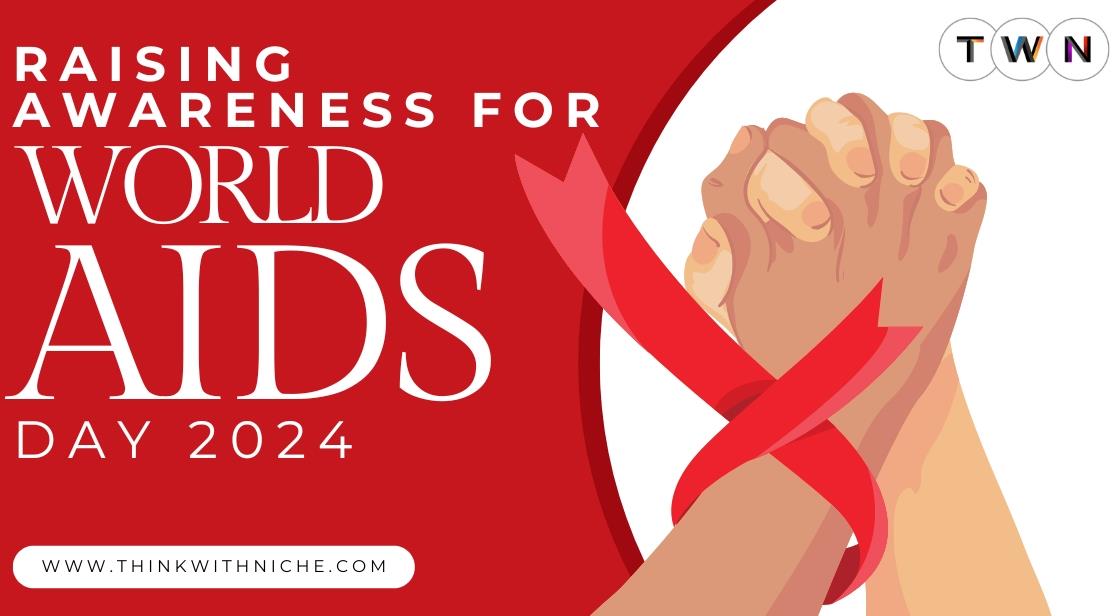Raising Awareness for World AIDS Day 2024

Blog Post
World AIDS Day, observed annually on December 1st, serves as a crucial reminder of the ongoing global fight against HIV/AIDS. Established in 1988, it was the first health day dedicated to raising awareness about the epidemic, remembering those who have lost their lives to AIDS-related illnesses, and honoring the progress made in the battle against the disease.
Despite significant strides in prevention, treatment, and education, HIV/AIDS continues to affect millions of people worldwide, making the importance of raising awareness more vital than ever. In 2024, the theme "Take the Rights Path: My Health, My Right!" emphasizes the need for health equity and human rights in the fight against HIV.
This day encourages individuals, communities, and organizations to unite, reduce stigma, and push for better access to testing, prevention, and treatment. The observance of World AIDS Day not only helps increase knowledge but also fosters compassion, reduces fear, and empowers people to take control of their health, contributing to the goal of an AIDS-free generation.
Supporting HIV Prevention and Awareness on World AIDS Day
World AIDS Day is observed annually on December 1st to honor the memory of those who have died from AIDS-related illnesses and to raise awareness about the ongoing battle against HIV/AIDS. Established in 1988, it was the first global health day dedicated to addressing the HIV/AIDS epidemic. This day provides an opportunity for people worldwide to come together, reflect on the progress made, and acknowledge the challenges that still remain in the fight against the disease.
Significance of World AIDS Day
The significance of World AIDS Day lies in its ability to unify individuals, governments, healthcare providers, and organizations globally in the fight against HIV. It helps to highlight the impact of the disease and reminds us of the importance of prevention, testing, and treatment. It also provides a platform for acknowledging the achievements in HIV research and the improved quality of life for people living with HIV due to advancements in antiretroviral therapy (ART).
Importance of Raising Awareness about HIV/AIDS
Despite the progress made, HIV/AIDS continues to affect millions of people worldwide. Awareness is crucial because there is still a significant amount of stigma and misinformation surrounding the disease. Raising awareness educates people about the importance of regular testing, safe practices, and early intervention. It also combats the social stigma faced by those living with HIV, promoting acceptance and support for affected individuals.
Global Impact and Need for Continued Education
HIV/AIDS remains a global health crisis, with millions of new infections each year. Education and awareness campaigns are critical in empowering individuals to protect themselves and others. Continuing efforts are essential to reduce transmission rates and work toward the ultimate goal of an AIDS-free generation.
History and Significance of World AIDS Day
How World AIDS Day Was Established in 1988
World AIDS Day was established in 1988 by the World Health Organization (WHO) and UNAIDS to create awareness about the global HIV/AIDS epidemic. The initiative was the first-ever global health day dedicated to a single disease. The idea was born out of the growing need to educate people, raise awareness, and combat the rising stigma associated with HIV/AIDS during the 1980s, when the disease was rapidly spreading and misunderstood. Since its inception, December 1st has been observed annually as World AIDS Day, providing a platform to acknowledge the challenges and promote collective action.
The Global Aim: Uniting Efforts, Reducing Stigma, and Providing Support
The primary goal of World AIDS Day is to unite global efforts in the fight against HIV/AIDS. It serves as a reminder to continue pushing for education, prevention, and treatment while fostering solidarity for those living with HIV. Over the years, World AIDS Day has become a crucial moment to acknowledge the human rights of people affected by the disease, reduce stigma, and show support to individuals living with HIV.
Key Milestones in the Fight Against AIDS
Several milestones have marked the fight against HIV/AIDS:
-
1980s: The discovery of HIV as the cause of AIDS and the first cases reported globally.
-
1996: The introduction of antiretroviral therapy (ART), which revolutionized HIV treatment and helped people live longer, healthier lives.
-
2015: The United Nations set the goal to end the AIDS epidemic by 2030, leading to further innovations in prevention, treatment, and global cooperation.
-
Ongoing: Campaigns for universal access to HIV treatment, and efforts to eliminate stigma and promote education continue worldwide.
The Theme for World AIDS Day 2024
The theme for World AIDS Day 2024 is "Take the Rights Path: My Health, My Right!". This theme emphasizes the importance of protecting and promoting human rights in the fight against HIV/AIDS. The World Health Organization (WHO) and other global partners are calling on leaders and citizens to address inequalities that hinder progress in ending AIDS by ensuring that everyone has access to quality healthcare services.
The theme highlights the need for health equity, reducing stigma and discrimination, and prioritizing vulnerable and marginalized populations. It's a powerful reminder that everyone deserves the right to health and that protecting human rights is essential to achieving an AIDS-free future.
Current Global Situation
Current Global Situation Statistics on HIV/AIDS globally, focusing on new cases, regional differences, and treatment access. Progress in treatment and prevention, including antiretroviral therapy (ART) and PrEP. Ongoing challenges, such as stigma, discrimination, and barriers to healthcare.
Here's a comprehensive overview of the current global situation regarding HIV/AIDS:
Current Statistics
-
People Living with HIV: As of 2023, approximately 39.9 million people globally were living with HIV.
-
New Infections: Around 1.3 million people became newly infected with HIV in 2023.
-
AIDS-related Deaths: Approximately 630,000 people died from AIDS-related illnesses in 2023.
-
Antiretroviral Therapy (ART): About 30.7 million people were accessing ART by the end of 2023.
Regional Differences
-
Sub-Saharan Africa: This region remains the most severely affected, with one in every 30 adults living with HIV. It accounts for more than two-thirds of the people living with HIV worldwide.
-
Asia and the Pacific: The burden of HIV varies significantly across countries in this region.
-
Eastern Europe and Central Asia: These regions have seen a rise in new infections in recent years.
Progress in Treatment and Prevention
-
Antiretroviral Therapy (ART): ART has transformed HIV from a fatal disease into a manageable chronic condition. The number of people on ART has increased significantly, from 7.7 million in 2010 to 30.7 million in 2023.
-
Pre-Exposure Prophylaxis (PrEP): PrEP is a preventive medication for HIV-negative individuals at high risk of infection. It has shown to be highly effective in reducing new infections.
-
Reduction in New Infections: New HIV infections have declined by 60% since 1995. Among children, new infections have declined by 62% since 2010.
Ongoing Challenges
-
Stigma and Discrimination: Social stigma and discrimination continue to be significant barriers to accessing healthcare and treatment.
-
Barriers to Healthcare: Many people, especially in rural and marginalized communities, face challenges in accessing healthcare services.
-
Testing and Diagnosis: Testing and diagnosis rates are still lower than needed, and many infected people remain unaware of their HIV status.
-
Funding and Resources: Sustained funding and resources are crucial to continue the progress and achieve the UNAIDS 95-95-95 targets by 2030.
Why Awareness is Still Crucial
The Persistent Misinformation and Myths Surrounding HIV/AIDS
Despite significant progress in understanding HIV/AIDS, misinformation and myths persist, particularly in vulnerable communities. Common misconceptions include the belief that HIV can be transmitted through casual contact like hugging or sharing utensils, or that it only affects certain groups. These myths create unnecessary fear and prevent individuals from seeking information, testing, or care. Awareness campaigns are essential in debunking these myths, providing accurate information, and combating misconceptions that hinder the fight against the epidemic.
The Stigma and Discrimination That People Living with HIV Face
Stigma remains one of the most significant barriers to HIV prevention and care. People living with HIV often face discrimination in their communities, workplaces, and healthcare settings. This stigma can lead to social isolation, mental health issues, and reluctance to seek treatment or disclose their status. In many parts of the world, fear of being ostracized stops individuals from getting tested for HIV or sharing their diagnosis with others. Raising awareness through education is crucial in addressing this stigma, fostering empathy, and encouraging inclusive behaviors towards people living with HIV.
The Role of Awareness Campaigns in Educating Communities, Reducing Fear, and Encouraging Testing and Prevention
Awareness campaigns play a pivotal role in educating the public about HIV transmission, prevention, and treatment. By providing clear, factual information, these campaigns help reduce fear and encourage people to take proactive steps towards HIV testing, safe sex practices, and prevention measures like PrEP (pre-exposure prophylaxis). Campaigns also highlight the importance of early diagnosis and the availability of effective treatments that allow individuals to live long and healthy lives. Public awareness reduces stigma, increases testing rates, and promotes healthier behaviors, ultimately aiding in the global fight against HIV/AIDS.
Promoting Testing and Prevention
Encouraging Regular HIV Testing
Regular HIV testing is crucial in preventing the spread of the virus. Knowing one's HIV status allows individuals to take early action, either by starting treatment if HIV positive or continuing preventive measures if HIV negative. Health experts recommend everyone between the ages of 13 and 64 get tested at least once, and more frequently for those at higher risk. Early detection through regular testing can help manage HIV effectively, reduce the risk of transmission, and promote a healthier life for people living with the virus.
Promoting Safe Sex Practices
Practicing safe sex is one of the most effective ways to prevent HIV transmission. This includes using condoms during vaginal, anal, and oral sex, which act as a barrier against the virus. Consistent and correct condom use is essential, and it is important to educate individuals about the effectiveness of condoms in preventing HIV and other sexually transmitted infections (STIs). Safe sex practices also include limiting the number of sexual partners and communicating openly with partners about HIV status.
Access to Clean Needle Programs
For people who inject drugs, access to clean needles and syringes is vital in reducing the risk of HIV transmission. Sharing needles or syringes is a major route for HIV spread, especially in areas with limited healthcare resources. Providing access to needle exchange programs can help reduce this risk, as well as offering support for addiction recovery, which can further reduce the likelihood of unsafe drug use.
Pre-Exposure Prophylaxis (PrEP)
Pre-exposure prophylaxis (PrEP) is a medication that people at high risk of HIV can take to prevent infection. When taken consistently, PrEP is highly effective in reducing the risk of contracting HIV. It is an essential preventive tool, especially for those with multiple sexual partners, those who inject drugs, or those with partners who are HIV-positive. Promoting awareness of PrEP and making it more accessible can play a critical role in the global effort to reduce new HIV infections.
Conclusion: Supporting HIV Prevention and Awareness on World AIDS Day
World AIDS Day is an important reminder of the ongoing global fight against HIV/AIDS and the need for continued awareness, education, and action. While significant progress has been made in the areas of prevention, treatment, and research, challenges remain, particularly with regard to stigma, discrimination, and access to healthcare. The theme for World AIDS Day 2024, "Take the Rights Path: My Health, My Right!" emphasizes the importance of human rights, health equity, and the need for collective action to address these issues.
You May Like
EDITOR’S CHOICE












